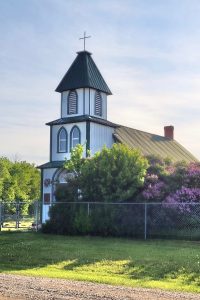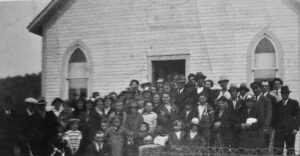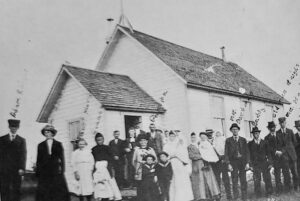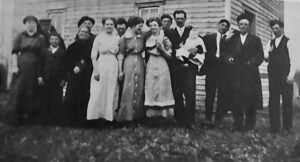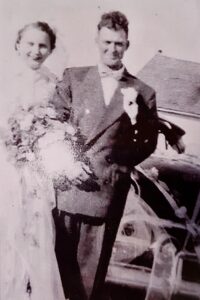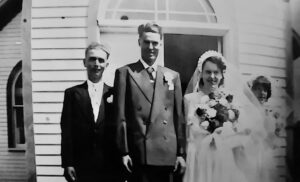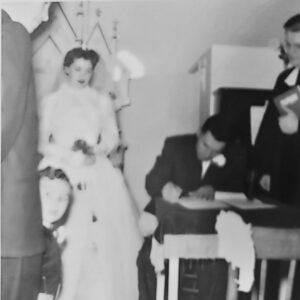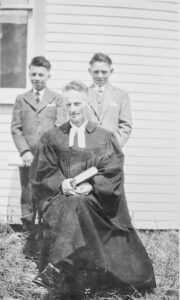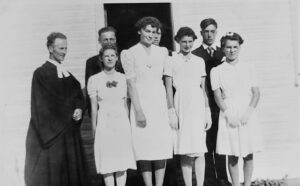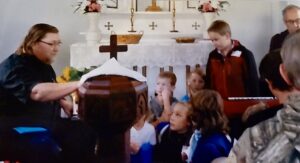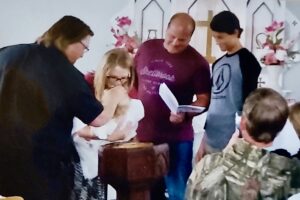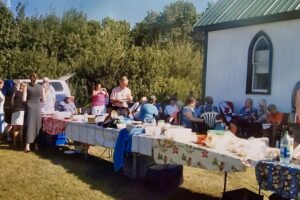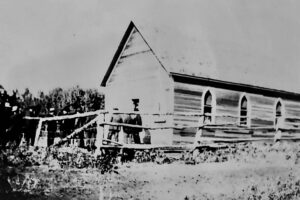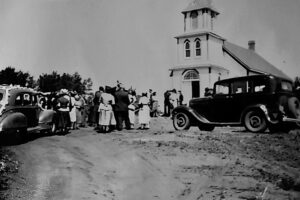The history of St. Paul’s Lutheran Church begins long before the building itself. In the late 1890s and early 1900s, Lutheran settlers—many of Russian and German origin—began to establish homesteads throughout the Silver Grove district. In those early years, before a formal place of worship existed, services were held in private homes. As more families arrived and the community grew, worship moved to the Silver Grove School, providing a more centralized location for gathering.
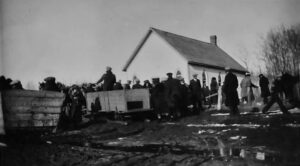
Photo of original construction of St. Paul’s Lutheran Church prior to the addition of the porch and steeple. Year unknown.
Recognizing the need for a dedicated place of worship, the congregation came together in 1917 to build St. Paul’s Lutheran Church. The land was generously donated by Adam Reidt, and both materials and labour were provided by the church’s own members—a testament to the strength and commitment of the community. Services were conducted in German, the language of many of the settlers, and the church quickly became a focal point for spiritual life across a large rural area where, at the time, families lived on nearly every quarter section.
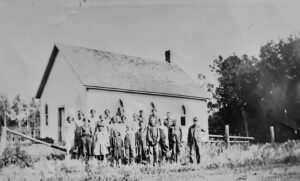
Photo of original construction of St. Paul’s Lutheran Church prior to the addition of the porch and steeple. Year unknown.
St. Paul’s became much more than a place of worship. It was a centre for learning, celebration, and community life. The church hosted Saturday School and Christmas programs—complete with towering Christmas trees—as well as baptisms, confirmations, weddings, funerals, and committals. Some of the earliest recorded milestones include the baptism of John Hugo Reidt in 1900 and confirmations dating as far back as 1902. Family names found in the church’s early registers reflect the cultural fabric of the district: Reidt, Riffer, Thiel, Bischler, Urbinsky, Ehrstein, Dehring, Schultz, Seiter, Dortman, Schlichemeyer, Saam, Hoffman, Edel, Bittner, Stieb, Hohn, Kron, Krause, Beck, Mueller, Sommerfeldt, Lenz, Rabel, Ruchotzke, Steinbart, Gutsch, Hek, Bergen, and Gampe.

Confirmation in 1943, with Reverend Sterzer seated, Arnold Sommerfeld, Milton Reidt, Willie Bischler and Walle Gutsch.

Photo of confirmation in 1932. Back: Eveline Schultz, Rose Urbinsky, Gotfried Ehrstein, John Bischler, Hertha Schultz
Front: Doris Thiel, Bena Bischler, Rev. Edwin Risch, Martha Schlichemeyer, Elizabeth Bischler
Pastors who served St. Paul’s over the decades included Rev. Hugo Lanz, Magnus, Weidenhammer, Freitag, Risch, Klingbeil, Schwabe, Penner, Adelsberger, Intscher, Sterzer, and Erickson—each leaving a mark on the spiritual life of the community.
As the decades passed, life in the countryside began to change. Families grew and moved away, farms became larger and fewer, and rural populations began shifting toward towns and cities. By the late 1950s, regular weekly services at St. Paul’s began to decline, particularly in the winter months. Church services started being held in Leask with increasing frequency and eventually became the norm. By the mid-1960s, worship at St. Paul’s had been reduced to an annual summer service and picnic—an occasion that continues to bring together descendants, neighbours, and friends.
In recognition of its historical and cultural significance, the Province of Saskatchewan officially designated St. Paul’s Lutheran Church a Municipal Heritage Site in 1984. This designation, along with ongoing support from former congregants, their families, and heritage grants, has helped ensure the preservation of the church building and grounds. Maintenance efforts have included significant repairs and upkeep, all carried out by volunteers committed to honouring the legacy of those who came before.
Today, more than a century since it was built, St. Paul’s Lutheran Church remains a beloved symbol of faith, community, and resilience. Though regular services have long ceased, the church continues to serve as a meaningful location for baptisms, weddings, funerals, and family reunions. It stands as a quiet witness to the lives and stories of those who made the Silver Grove district their home—and a place where new generations can connect with that enduring heritage.

